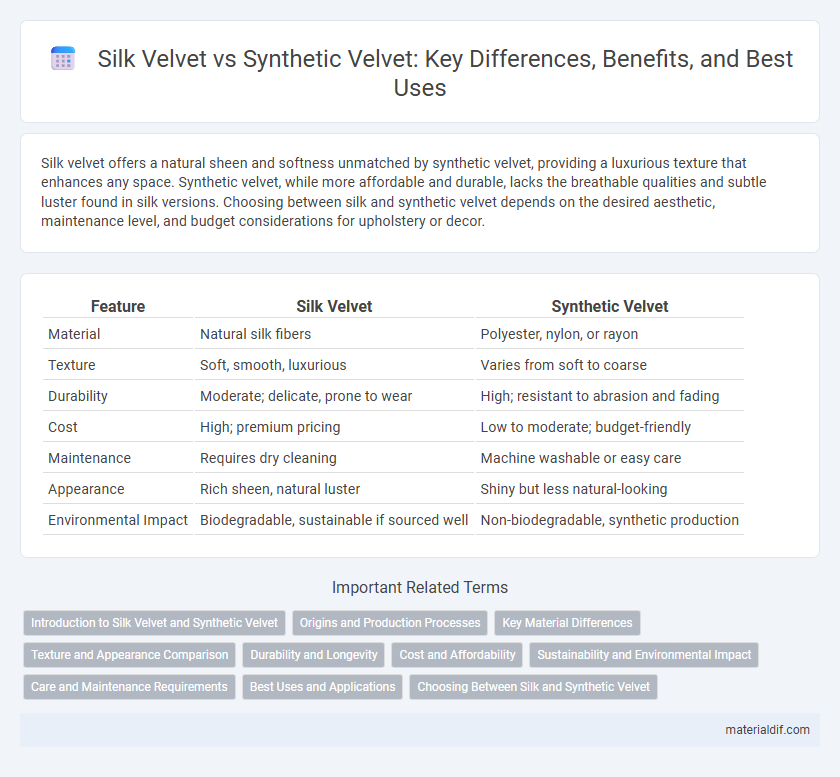Silk velvet offers a natural sheen and softness unmatched by synthetic velvet, providing a luxurious texture that enhances any space. Synthetic velvet, while more affordable and durable, lacks the breathable qualities and subtle luster found in silk versions. Choosing between silk and synthetic velvet depends on the desired aesthetic, maintenance level, and budget considerations for upholstery or decor.
Table of Comparison
| Feature | Silk Velvet | Synthetic Velvet |
|---|---|---|
| Material | Natural silk fibers | Polyester, nylon, or rayon |
| Texture | Soft, smooth, luxurious | Varies from soft to coarse |
| Durability | Moderate; delicate, prone to wear | High; resistant to abrasion and fading |
| Cost | High; premium pricing | Low to moderate; budget-friendly |
| Maintenance | Requires dry cleaning | Machine washable or easy care |
| Appearance | Rich sheen, natural luster | Shiny but less natural-looking |
| Environmental Impact | Biodegradable, sustainable if sourced well | Non-biodegradable, synthetic production |
Introduction to Silk Velvet and Synthetic Velvet
Silk velvet is a natural fabric made from silk fibers, renowned for its luxurious texture, sheen, and durability, often used in high-end fashion and upholstery. Synthetic velvet, typically crafted from polyester or nylon, offers a more affordable, wrinkle-resistant alternative with easier maintenance but lacks the softness and breathability of silk. Understanding the material composition and performance characteristics of silk versus synthetic velvet helps in selecting the right fabric for specific applications.
Origins and Production Processes
Silk velvet originates from natural silkworm fibers, produced through a labor-intensive process involving sericulture and hand-weaving, resulting in a soft, breathable fabric with a luxurious sheen. Synthetic velvet, primarily made from polyester or nylon, is created through industrial methods using chemical polymers and machine weaving, offering durability and cost-effectiveness but lacking the natural breathability and luster of silk. The fundamental difference in origins--organic silkworm cultivation versus chemical fiber synthesis--shapes the tactile qualities and environmental impact of each velvet type.
Key Material Differences
Silk velvet features natural protein fibers from silkworms, offering a lustrous sheen, superior softness, and high breathability, whereas synthetic velvet, typically made from polyester or nylon, provides greater durability and resistance to stains but lacks the natural moisture-wicking properties. The natural cellulose structure of silk velvet allows for a smoother texture and more luxurious feel compared to the often slightly rougher surface of synthetic alternatives. Silk velvet is biodegradable and hypoallergenic, making it environmentally friendly and ideal for sensitive skin, while synthetic velvet's resilience suits heavy-use applications but may contribute to microplastic pollution.
Texture and Appearance Comparison
Silk velvet features a natural sheen and a plush, soft texture that reflects light beautifully, giving it an elegant and luxurious appearance. Synthetic velvet often mimics this look but tends to have a slightly stiffer feel and less depth in its luster due to the use of polyester or nylon fibers. The texture of silk velvet is smoother and more breathable, while synthetic options can sometimes feel less natural but offer greater durability and resistance to wear.
Durability and Longevity
Silk velvet offers exceptional durability due to its natural protein fibers, which provide resilience and maintain texture over time, making it ideal for high-end upholstery and fashion. Synthetic velvet, typically made from polyester or nylon, excels in longevity by resisting wear, stains, and fading, ensuring prolonged use with minimal maintenance. While silk velvet boasts a luxurious feel, synthetic velvet provides superior durability and easier care, making it a practical choice for everyday applications.
Cost and Affordability
Silk velvet, crafted from natural silk fibers, commands a higher price due to its luxurious texture and durability, making it a premium choice for high-end applications. Synthetic velvet, often made from polyester or nylon, offers a more budget-friendly alternative with easier maintenance and greater resistance to wear. Consumers balancing cost and quality frequently opt for synthetic velvet to achieve the velvet aesthetic without the elevated expense of silk.
Sustainability and Environmental Impact
Silk velvet, derived from natural silk fibers, offers superior biodegradability and lower environmental impact compared to synthetic velvet, which is typically made from petroleum-based fibers like polyester and nylon. The production of synthetic velvet involves energy-intensive processes and generates microplastic pollution, contributing to environmental degradation. Choosing silk velvet supports sustainable textile practices by reducing reliance on fossil fuels and promoting renewable resources.
Care and Maintenance Requirements
Silk velvet requires delicate care with gentle hand washing or dry cleaning to preserve its natural fibers and lustrous texture, while synthetic velvet offers greater durability and can often withstand machine washing on a gentle cycle. Avoid exposure to direct sunlight on silk velvet to prevent fading, whereas synthetic velvet is more resistant to color loss and wear. Regular vacuuming and prompt stain treatment are essential for both types to maintain their plush appearance and longevity.
Best Uses and Applications
Silk velvet offers luxurious softness and natural breathability, making it ideal for high-end fashion, upholstery, and drapery where elegance and comfort are paramount. Synthetic velvet, such as polyester or nylon blends, provides greater durability, stain resistance, and affordability, suited for heavy-use furniture, costumes, and commercial decor. Choosing between silk and synthetic velvet depends on desired texture, maintenance, and application environment.
Choosing Between Silk and Synthetic Velvet
Choosing between silk and synthetic velvet depends on factors such as texture, durability, and cost. Silk velvet offers a luxurious, smooth feel with natural breathability and a subtle sheen, making it ideal for high-end garments and upholstery. Synthetic velvet provides greater durability, stain resistance, and affordability, suitable for heavy-use applications and budget-conscious projects.
Silk velvet vs synthetic velvet Infographic

 materialdif.com
materialdif.com